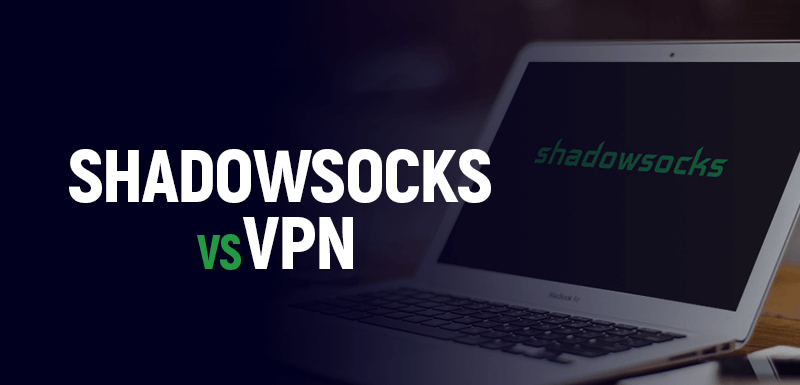Most new inductees into the world of VPNs confuse Shadowsocks and VPNs for being the same. The truth is very different, with both serving different use cases. We’ll analyze the Shadowsocks VS VPN debate and simplify it for you.
We’ll unravel and explain the main differences between Shadowsocks and VPN. We’ll also look at their security and use cases to help you determine and customize your experience. So let’s get started!
Shadowsocks VS VPN: The Main Difference
Shadowsocks is an internet proxy protocol that masks your ID, while a VPN is a service that encrypts your data thoroughly. Shadowsocks works on the Sock5 protocol that encrypts your IP address to ensure anonymity while you surf the internet.
While VPNs may offer Shadowsocks support, most VPN services offer other security protocols like WireGuard and OpenVPN. Instead of only encrypting your IP address, a VPN encrypts all your data or traffic and passes it through a secure private tunnel.
Here’s a simple example, using a proxy like Shadowsocks is similar to wearing a mask. When you use a VPN, it’s like getting plastic surgery to make yourself completely unrecognizable. On the same note, VPNs are more extensive and taxing on internet connections.
While Shadowsocks is faster but also less secure. In simpler words, you can pop on a mask whenever you like, but you still have the same face beneath the mask. You’ll understand it more clearly when you read the concept Shadowsocks is based on.
Relationship Between Shadowsocks and Socks5
Shadowsocks is a client software that uses Socks5 as the basic protocol. Think of it like a corridor that connects you to the Socks5 protocol. In 2012, the Chinese government cracked down on the Internet. Numerous sites and applications were banned to curb “foreign influence.”
To escape the growing restrictions, a Chinese programmer named “Clowwindy” improved upon the Socks5 protocol and made a custom client software. He named it Shadowsocks and posted it on GitHub. Over the years, hundreds of people changed and customized it to their needs.
Shadowsocks became widely popular in China. It was the first-of-its-kind proxy connector that could bypass Deep Packet Sniffing to avoid ISP peeking.
How Does Socks5 Work?
When you use Socks5 using Shadowsock or any other service, it connects you to a proxy server. The proxy server changes your IP, so when you visit a website, your proxy server IP is read instead of the real one. Since ISPs use your IP address to identify you, your identity becomes indistinguishable.
Socks5 is also a notch above classic HTTP Proxies because Socks5 covers a wider traffic range. HTTP Proxies may have to cover an underlying protocol like FTP, while Shadowsocks through Socks5 works on a lower level, using the Handshake protocol. It makes it much more secure and faster.
Socks5 was and still is a great option for accessing restricted content, but other than that, it loses functionality. It does have applications that we will look at below.
Shadowsocks VS VPN Comparison
Where should you use Shadowsocks VS VPNs? Both Shadowsocks and VPNs have their uses and functionality. Our job is to determine which one is best for which situation. With that in mind, let’s look at their functionality and uses.
Shadowsocks VS VPN Functionality
VPNs are an all-in-one deal that offers both security and anonymity. You can use a VPN to:
- Keep your online activity anonymous
- Bypass geo-restricted content
- Block ads
- Keep malware away
Shadowsocks has one sole purpose, and that is to mask your IP address. Naturally, you can use Shadowsocks to:
- Bypass geo-restricted content
You can’t do anything else with Shadowsocks because it doesn’t have any in-built security functions.
Shadowsocks VS VPN Speed
Since VPNs offer more versatility and dependability, they are a better option. At the same time, VPNs affect your speed. A good VPN will drop your speed by 10 to 20%. A bad VPN could drop your speed by more than 80%.
Shadowsocks is better when it comes to speed. It only encrypts your IP, which makes it much faster. But at the same, it doesn’t encrypt your data, so your ISP can still see what you’re doing. They just don’t know who is doing it!
In simple analogy terms, a VPN is a slightly slow but very robust tank, while Shadowsocks is a Ferrari made of glass, very fast but easily breakable.
Shadowsocks VS VPN Uses
Since both Shadowsocks and Socks5 allow IP masking, you can easily use either one to access geo-restricted content. If you don’t need to hide your activity but want to hide your identity, you can use Shadowsocks.
You’ll have great streaming speeds, but your data will remain discernible. For example, a lot of mainstream platforms are banned or restricted in China, like:
- YouTube
- Wikipedia
- Bloomberg
The services that do operate have to abide by the government’s policies. The strict environment in the country has spawned homegrown apps and services.
Instead of WhatsApp, China has WeChat. In place of Google Search and Google Pay, China has Baidu and AliPay, respectively. You can easily unblock and access these services in China using Shadowsocks. However, your ISP will still see the content that you’re accessing.
If you want complete anonymity and aren’t worried much about speed, use a VPN like NordVPN. A VPN encrypts your traffic, masks your ID, and offers a secure tunnel no one can see.
Shadowsocks VS VPN: Which One Is Better?
In pure functionality, VPNs are better than Shadowsocks. Modern VPNs also offer obfuscated servers and SmartDNS for unblocking content in extremely restricted countries. VPNs also offer different protocols for better speed and connectivity.
If you want only speed for torrenting or general surfing, Shadowshocks is better. In the end, the answer is subjective to the user. You can choose a Proxy or VPN based on your needs. However, we always recommend using a VPN because some modern VPNs offer Socks5 support.
An example of this is NordVPN. It is the only VPN that offers a connection to Socks5 proxy servers. You can find the SOCKS5 connectivity guide on their website.
Conclusion
In the briefest and simplest terms, Shadowsocks is a client software that connects to SOCKS5 proxy servers. VPNs are applications that offer wider connectivity and security. Shadowsocks is better for speed but offer no security, while VPNs are a bit slower but offer more security.
If you want to use Shadowsocks or Socks5 servers, you can try NordVPN. It’s one of the few VPN providers that offers Sock5 support. That ties up the Shadowsocks VS VPN debate.
FAQs
Is Shadowsocks better than a VPN?
Shadowsocks is better than a VPN for speed. However, it doesn’t offer much security. Your data is still out in the open for your ISP and hackers to see. VPNs offer much better security by encryption your data through their protocols and AES 256 algorithms.
Is Shadowsocks Safe?
Shadowsocks encrypt your IP address and hide your identity. However, it doesn’t necessarily offer protection against malware, pop-ups, or hackers. Additionally, you have to connect to proxy servers to use Shadowsocks. Some proxy servers are not safe.
Is Shadowsocks banned in China?
The whole idea behind Shadowsocks is to make it hard to block. Naturally, it’s beyond the authority of the government to block Shadowsocks. However, proxy servers that offer Shadowsocks have been blocked and banned in China over the years. For example, in Nov of 2021, Shadowsocks were blocked on China’s VMess servers.






Leave a Reply